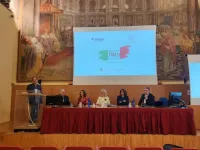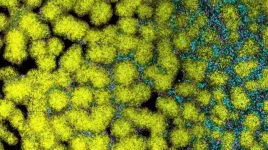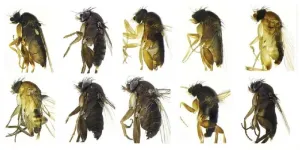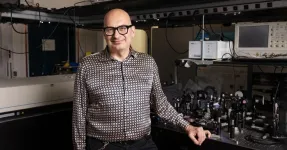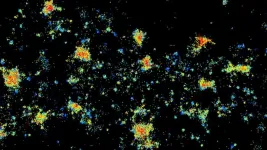(Press-News.org) A self-proclaimed Brazil-Italy collaboration enthusiast, researcher Laura Bolognesi created the B2AlzD2 Joint Lab at the Department of Pharmacy and Biotechnology of the Università di Bologna (UNIBO), the first Brazil-Bologna joint laboratory dedicated to the development of new drugs for the treatment of Alzheimer’s disease. The partners include scientists from four Brazilian universities: the Federal University of Rio de Janeiro (UFRJ), the University of Brasília (UnB), the University of São Paulo (USP Ribeirão Preto) and the Federal University of Minas Gerais (UFMG).
One of the laboratory’s ongoing projects is to identify compounds with the potential for drug development in industrial waste, particularly in cashew nut shell liquid (CNL), a natural oil considered to be a by-product of the industrial processing of cashew nuts, with a high content of phenolic compounds.
The line of research and the principles that guide the group’s work were presented by Bolognesi on Tuesday (Oct 15th) in a panel discussion on health and the environment that was part of the program of FAPESP Week Italy.
“We need to integrate the concept of sustainability into the search for bioactive molecules. This must be the keyword,” said Bolognesi in her presentation. “If we adopt waste as a raw material for drug development, the products resulting from the research will be inherently sustainable.”
The group’s work also takes a One Health approach, Bolognesi said. Conceived at the turn of the century, this concept refers to an integrated approach that recognizes the link between human, animal, plant and environmental health. “It’s a holistic vision in which everyone involved must be included. We believe that it’s not enough just to find a new drug that’s potent and bioavailable. It must also be accessible to the people who need it. In the case of Chagas disease, for example, more than 90% of affected patients don’t have access to treatment, even though they live in three major economies [Brazil, Argentina and Mexico],” she noted.
Another concern of the B2AlzD2 Joint Lab, said Bolognesi, is to integrate green chemistry principles into its drug development pipeline.
Neglected diseases
Luiz Carlos Dias, a professor at the State University of Campinas (UNICAMP), was another member of the panel. He presented the work of an international consortium created to support the search for new drugs against Chagas disease and malaria. The initiative brings together UNICAMP, USP and two non-profit organizations: the Drugs for Neglected Diseases Initiative (DNDi) and the Medicines for Malaria Venture (MMV). The group is supported by FAPESP through the Research Partnership for Technological Innovation Program (PITE) (read more at: agencia.fapesp.br/32265).
“Our work touches on several SDGs [Sustainable Development Goals of the 2030 Agenda], and its central goal is to reduce the time it takes to discover drugs,” he said.
Dias explained to Agência FAPESP that the consortium receives information from the DNDi and the MMV about the structure of the molecules to be studied, all of which are off-patent. “We synthesize the substances at UNICAMP, purify them and send them to various Brazilian laboratories in the network to be tested against the parasite. For those that show anti-parasitic activity, we develop analogous molecules with minor modifications to try to increase potency, stability and safety. Only after many in vitro tests have we moved on to animal testing. Our challenge now is to develop a viable compound for a clinical trial.”
At the beginning of the project, he said, this entire pre-clinical testing phase was done outside Brazil because there was no installed capacity in the country. “Today, we do the whole cascade of tests, the primary and secondary parasitology part. We’ve acquired a competence that we didn’t have because the country never invested in drug discovery and development. We’ve built a network with various partners with experience in different areas,” he commented.
Dias reflects that the group’s challenges are great and the goals are ambitious: to develop low-cost drugs that are safe enough to be used by children and pregnant women, who are among the main populations affected by these neglected diseases.
In the case of malaria, there is an additional challenge: treatment must be a single dose, taken orally. “Plasmodium acquires resistance very quickly. We need a drug that can eliminate it in ten days, with a single dose, to get around that problem,” he said.
The panel also featured Monica Cricca, a researcher at UNIBO’s Department of Medical and Surgical Sciences who develops equipment for diagnosing infections. One of her group’s goals is to develop a surveillance system for detecting Candida auris, a superfungus that is resistant to several classes of drugs and capable of causing serious infections.
She said that the pathogen spread throughout Italy during the COVID-19 pandemic, a phenomenon that was also observed in Brazil (read more at: agencia.fapesp.br/36111). “We’re trying to implement a surveillance system to limit its spread,” she said.
The topic of antimicrobial resistance was also addressed by Ana Cristina Gales, professor at the Federal University of São Paulo (UNIFESP) and vice-coordinator of the Antimicrobial Resistance Institute of São Paulo (ARIES Project), supported by FAPESP through the Research, Innovation and Dissemination Centers program (RIDCs).
The panel also included Carmino Antonio de Souza, professor at UNICAMP, vice-president of FAPESP and one of the founders of the Italian-Brazilian Association of Hematology (AIBE), which aims to promote the integration of hematology services in both countries through the exchange of health professionals and the development of clinical and laboratory protocols of common interest.
The discussions were moderated by Bolognesi and Niels Olsen Saraiva Câmara, professor at USP and advisor to FAPESP’s scientific director.
END
Researchers from Brazil and Italy search industrial waste for new Alzheimer’s drugs
One of the raw materials studied by the group is cashew nut shell liquid, a by-product of oilseed processing; work was presented during FAPESP Week Italy.
2024-10-17
ELSE PRESS RELEASES FROM THIS DATE:
BU, Boston Medical Center researchers join forces with GSK to fight lung diseases
2024-10-17
(Boston)—Researchers from the Center for Regenerative Medicine (CReM) at Boston University and Boston Medical Center (BMC) have announced a new collaboration with the global biopharma company GSK to advance innovative research focused on developing cutting-edge models to study and treat lung diseases like pulmonary fibrosis.
Pulmonary fibrosis, including its most common form, idiopathic pulmonary fibrosis (IPF), is a progressive and life-threatening condition that results in scarring of the lungs, making it increasingly difficult for patients to breathe. ...
Bacteria thrive by playing nice before going their own way
2024-10-17
Biofilms — slimy communities of bacteria — grow on all sorts of surfaces: from glaciers and hot springs to plant roots, your bathtub and fridge, wounds, and medical devices such as catheters. Most biofilms are composed of multiple bacterial species, but how these species manage to live together is unclear.
A new study by Dartmouth scientists in Current Biology uses experiments and modeling to delve into how three species of biofilm bacteria coexist — and when they move out on their own. One species, Pseudomonas aeruginosa, a verstaile pathogen known to be antibiotic resistant, dominated ...
Identifying the genes that viruses ‘steal’ from ocean microbes
2024-10-17
COLUMBUS, Ohio – The microbes that cycle nutrients in the ocean don’t do the work on their own – the viruses that infect them also influence the process. It’s a vital job for the rest of the planet, enabling oceans to absorb half of the human-generated carbon in the atmosphere and produce half of the oxygen we breathe.
A new study gets scientists closer to more fully understanding where viruses fit into the global ocean picture of cycling nutrients such as nitrogen, phosphorous and, of particular interest, carbon. The research broadly expands on a 20-year-old finding that genes can be exchanged between viruses and the photosynthetic ...
CDC/PEPFAR awards Georgetown $27.5 million to address HIV/AIDS in Haiti
2024-10-17
WASHINGTON (Oct. 17, 2024) -- The U.S. Centers for Disease Control and Prevention (CDC) and the President’s Emergency Plan for AIDS Relief (PEPFAR), have awarded $27.5 million to the Center for Global Health Practice and Impact (CGHPI) at Georgetown University Medical Center to expand its ongoing work in Haiti to address HIV/AIDS.
For the 150,000 people in Haiti living with HIV, losing access to basic life-saving therapy can lead to unnecessary suffering, risk of transmission to others, and ...
Found hundreds of species using DNA barcoding
2024-10-17
The Earth is an almost unimaginably diverse planet in terms of species. Researchers have identified between two and three million species, but there are many more that we know nothing about.
The unknown species are called ‘biological dark matter’, borrowing a term from astrophysics.
“We want to demonstrate how we can gain a better overview of biological dark matter by using DNA barcoding,” said Associate Professor Emily Hartop.
DNA barcoding, in this case so-called ‘megabarcoding’, might sound mysterious, but it isn’t really. We will come back to that later. First, let us take a look at why ...
Unpaid caregiving is undervalued by society
2024-10-17
WASHINGTON — Americans believe volunteering to help strangers contributes more to society than providing care for family or friends, even though they contribute billions of dollars’ worth of labor in unpaid caregiving every year, according to research published by the American Psychological Association.
This perception could lead Americans of lower socioeconomic status to feel like they have less to contribute than people of higher socioeconomic status, because they often do not have the same amount of time or resources to devote to people outside of their communities.
“Over ...
AI helps to detect antibiotic resistance
2024-10-17
Researchers at the University of Zurich (UZH) have used artificial intelligence (AI) to help identify antibiotic-resistant bacteria. The team led by Adrian Egli, UZH professor at the Institute of Medical Microbiology, is the first to investigate how GPT-4, a powerful AI model developed by OpenAI, can be used to analyze antibiotic resistance.
The researchers used AI to interpret a common laboratory test known as the Kirby-Bauer disk diffusion test, which helps doctors to determine which antibiotics can or can’t fight a particular bacterial infection. Based on GPT-4, the scientists created the “EUCAST-GPT-expert”, which follows strict EUCAST ...
Scientific conference series aims to improve outcomes for diabetes, cancer and cardiovascular disease
2024-10-17
WASHINGTON—The Endocrine Society, a global organization that promotes endocrinology research and clinical practice, and Keystone Symposia, a nonprofit host of conferences and symposia on a range of life science and biomedical topics, will jointly host a series of three conferences to advance endocrine research.
The three conferences will focus on diabetes, oncology and cardiovascular disease—hormone-related conditions that have a major impact on public health. The conference series is slated to launch in late 2026 or early 2027 and will run ...
Quantum research breakthrough uses synthetic dimensions to efficiently process quantum information
2024-10-17
Quantum research breakthrough uses synthetic dimensions to efficiently process quantum information
The discovery, at INRS, of a synthetic photonic lattice capable of generating and manipulating quantum states of light, offers promising prospects for a variety of applications, from quantum computing to secure quantum communication protocols.
A study co-directed by Professor Roberto Morandotti of Institut national de la recherche scientifique (INRS) in collaboration with teams from Germany, Italy, and Japan opens the door to cutting-edge solutions ...
Putting out a brain on fire
2024-10-17
Imagine you wake up in a hospital without a single memory of the last month. Doctors say you had a series of violent episodes and paranoid delusions. You’d become convinced you were suffering from bipolar disorder. Then, after a special test, a neurologist diagnoses you with a rare autoimmune disease called anti-NMDAR encephalitis. This is what happened to Susannah Cahalan, a New York Post reporter who would go on to write the best-selling memoir Brain on Fire: My Month of Madness.
Anti-NMDAR encephalitis can lead to hallucinations, blackouts, and ...
LAST 30 PRESS RELEASES:
Decoupling the HOR enhancement on PtRu: Dynamically matching interfacial water to reaction coordinates
Sulfur isn’t poisonous when it synergistically acts with phosphine in olefins hydroformylation
URI researchers uncover molecular mechanisms behind speciation in corals
Chitin based carbon aerogel offers a cleaner way to store thermal energy
Tracing hidden sources of nitrate pollution in rapidly changing rural urban landscapes
Viruses on plastic pollution may quietly accelerate the spread of antibiotic resistance
Three UH Rainbow Babies & Children’s faculty elected to prestigious American Pediatric Society
Tunnel resilience models unveiled to aid post-earthquake recovery
Satellite communication systems: the future of 5G/6G connectivity
Space computing power networks: a new frontier for satellite technologies
Experiments advance potential of protein that makes hydrogen sulfide as a therapeutic target for Alzheimer’s disease
Examining private equity’s role in fertility care
Current Molecular Pharmacology achieves a landmark: real-time CiteScore advances to 7.2
Skeletal muscle epigenetic clocks developed using postmortem tissue from an Asian population
Estimating unemployment rates with social media data
Climate policies can backfire by eroding “green” values, study finds
Too much screen time too soon? A*STAR study links infant screen exposure to brain changes and teen anxiety
Global psychiatry mourns Professor Dan Stein, visionary who transformed mental health science across Africa and beyond
KIST develops eco-friendly palladium recovery technology to safeguard resource security
Statins significantly reduce mortality risk for adults with diabetes, regardless of cardiovascular risk
Brain immune cells may drive more damage in females than males with Alzheimer’s
Evidence-based recommendations empower clinicians to manage epilepsy in pregnancy
Fungus turns bark beetles’ defenses against them
There are new antivirals being tested for herpesviruses. Scientists now know how they work
CDI scientist, colleagues author review of global burden of fungus Candida auris
How does stroke influence speech comprehension?
B cells transiently unlock their plasticity, risking lymphoma development
Advanced AI dodel predicts spoken language outcomes in deaf children after cochlear implants
Multimodal imaging-based cerebral blood flow prediction model development in simulated microgravity
Accelerated streaming subgraph matching framework is faster, more robust, and scalable
[Press-News.org] Researchers from Brazil and Italy search industrial waste for new Alzheimer’s drugsOne of the raw materials studied by the group is cashew nut shell liquid, a by-product of oilseed processing; work was presented during FAPESP Week Italy.
